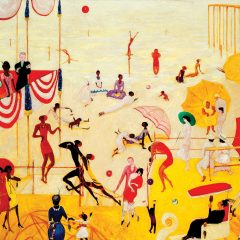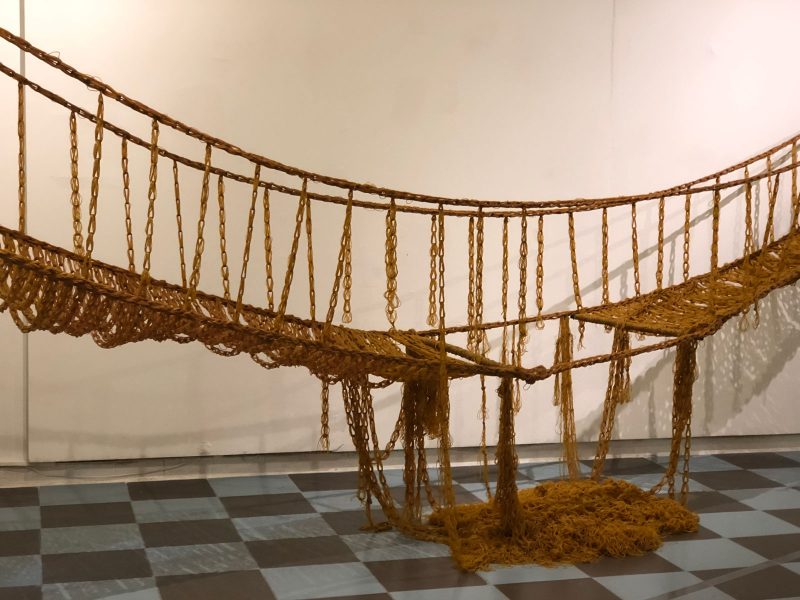
I recently attended two, the oldest and most well-known, the International Art Exhibition of La Biennale di Venezia (founded 1895), and a much newer Jerusalem Biennale (founded 2013). It was my first visit to any Biennale, and my first time curating a show for one, which for me was an exhibition of work by two artists for the Jerusalem Biennale, Dorit Feldman and Rachel Rotenberg.
For those not familiar with the Venice Biennale, it is a huge undertaking that takes over the city for about six months every two years (11th May to 24th November 2019) and includes theater, music, dance, and performance. There are prizes and this year’s Golden Lion was awarded to “Sun & Sea (Marina)” Lithuanian Pavilion. An opera, it is a collaboration between three artists: the filmmaker Rugilė Barzdžiukaitė, writer, playwright, and poet, Vaiva Grainytė, and artist, musician and composer Lina Lapelytė. The curator of the pavilion is Lucia Pietroiusti. A live production of this scale is quite expensive and therefore performances have been limited, but you can view an hour of the performance on the internet. The setting is a beach within an industrial building and the theme is climate change, a topic that fits within the Venice Biennale’s larger theme: “May You Live in Interesting Times.” Sadly, the city recently experienced historic flooding and faces tremendous environmental threats.
Ralph Rugoff, the curator of the Venice Biennale 2019, explains in the comprehensive two volume catalog for the Biennale, that many works in “Proposition A,” the area with national pavilions and located in the Arsenale, explore topics of urgency: climate change, a return to nationalist agendas, growing inequality, and the power of social media. However, finding that artists often have complex multi-dimensional practices, the second avenue of exploration, “Proposition B,” is to show other work by these same artists in the Giardini’s huge Central Pavilion. This is a different type of organization from past Biennales.* You must take a boat to yet another location to see “Sun and Sea.”
To view all this as well as attend performances and visit related venues around the city requires commitment. For those who live within a four-hour flight distance, multiple visits might be undertaken. For those of us who come from a distance and purchase one three-consecutive-day ticket, the experience is immersive and intensive, and only a few venues can be included in this review. While visitors often don’t read labels, if you do, you will notice that many of the artists may be international, but they are often represented by US galleries, especially galleries in New York City and Los Angeles with Chicago coming in a distant third. The gallery connection is one that indicates the presence of the international art market in the Biennale.
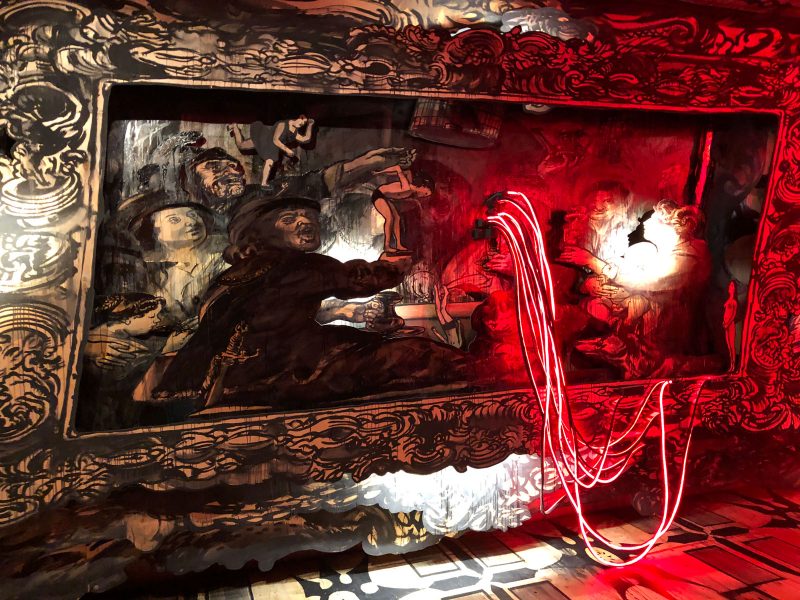
The Russian Pavilion installation, “Lc. 15: 11-32,” curated by The State Hermitage Museum and the General Director Mikhail Piotrovsky, concentrates on the fabulous art collection of the Hermitage Museum, and is designed by the film director Alexander Sokurov, who dedicates a central space to the Hermitage’s Rembrandt collection. It is cinematic, dramatic, and almost claustrophobic. The title refers to the “Parable of the Prodigal Son,” a subject depicted by Rembrandt. The theme, that of mercy, forgiveness, and compassion connects to the general theme of the Biennale. A second installation with kinetic sculpture and sound, designed by Alexander Shiskin-Hokusai, refers to such mechanisms as the famous Peacock Clock in the Winter Palace.
Denmark presents a powerful and stunning, black and white film, “In Vitro,” on the topics of memory and displacement by Danish-Palestinian artist Larissa Sansour, whose practice is multidisciplinary, encompassing film, photography, installation, and sculpture. There is an accompanying installation, “Monument for Lost Time.” Together the project is entitled “Heirloom,” and its development is documented in a book. The film is highly produced and combines an exploration of contested geographies with science fiction. Here a world has gone underground after ecological disaster, thus combining themes of memory and identity with climate change.
Saudi Arabia’s contribution, “After Illusion,” by Participant Zaharah Al Ghamdi and Project Advisor Nada Shabout, also explores time with curator Eiman Elgibreen explaining that while Saudi history may be defined by two historical moments, the emergence of Islam and the discovery of oil, nonetheless the Saudi people utilize poetry and oral history for inspiration. The installation includes leather vessels created by Al Ghamdi.** They sit in piles amidst a flowing and running curtain with sound in the background. It is a striking installation that suggests the syntax of poetry and the history of the region.
Quite different is “Martin Puryear: Liberty/Libertà,” installed in the 1930 classically-styled United States of America Pavilion. The curator is Brooke Kamin Rapaport who oversees the outdoor public sculpture programs of contemporary art in NYC. It is powerful, beautifully crafted, and historical. A huge construction, “Swallowed Sun (Monstrance and Volute)” of wood covers the front of the Jeffersonian-styled building. It is a collaboration with Tod Williams Billie Tsien Architects. From the front, the huge wooden fence suggests the kind of 18th century fencing found around elegant buildings in the South and featured in Williamsburg, VA. From the back, it connects to a huge polyester and rope spiral, possibly signifying the complexity of American history which seems to repeat and spiral back on itself. A work that sits in the center of the pavilion is particularly haunting, “A Column for Sally Hemings,” the young enslaved woman with whom Thomas Jefferson had six children.*** As in all Puryear work, it is an abstract representation; here a column acts as a skirt, and cast iron shackles represent her neck and head.
Including several suns is Latvian artist Daiga Grantina’s “Saules Suns.” A whimsical installation comprised of less permanent materials, various forms sprawl across a less polished gallery space. The curators describe the work as a “playground for the eye.” Certainly, the prosaic materials—metal, wood, cotton, flax, thread, paper, flax fiber, and plastics—contrast with some of the more monumental installations and reflect a humbler way of seeing the world. Ghana, with its first contribution to the Biennale, also involves artists using humble materials, the most well-known being El Anatsui, who creates large curtains with things like discarded aluminum cans. His work here does not disappoint.
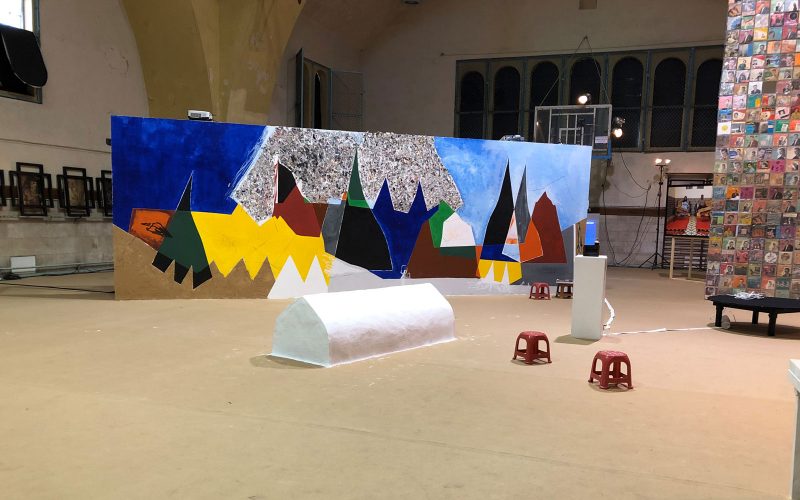
There are too many works to discuss in one brief article, but you can visit the Venice Biennale website to learn about other artists and pavilions. If you go to Venice, you should also visit the Peggy Guggenheim Museum, which has a new exhibition on view: “Peggy Guggenheim: The Last Dogaressa.” She has history with the Venice Biennale, having been invited to exhibit her collection at the 24th Venice Biennale in 1948, its first presentation in Europe after the closure of her Art of This Century Gallery, NYC. It is a terrific introduction to her collection and Guggenheim’s importance to modern art.(On view through January 27, 2020)
The Jerusalem Biennale is also multidisciplinary with concerts, dance, and performance, and includes the work of 200 artists in 30 exhibitions spread across the city (through November 28, 2019).The theme is that any dispute for the sake of heaven will survive, while those without those intentions will not endure, an idea taken from the Mishnah, Ethics of the Fathers, 5:17. While most of the artists live and work in Israel, there are 15 from other countries. Rami Ozari, Founder and Director of the Jerusalem Biennale curated or co-curated several exhibitions and has commented that discourse and discord lie at the heart of creativity. The Deputy Director is Dr. Ido Noy, who was instrumental in the content of the Biennale as well as its catalogue editor. Although there are artists included who have gallery representation, many appear to operate outside the gallery system.
Not all exhibitions had yet opened by the time I departed Israel, but of those viewed, quite a number stand out. At the YMCA there are several installations. One of the most fascinating is “Ziara: Common Moroccan Wisdom,” curated by Amit Hal Cohen, and including both Muslim and Jewish artists who are currently from Morocco or who can trace their roots to Morocco. The exhibition sees no difference between popular culture and fine art and craft and ranges from photography to painting, to sculpture, to vinyl covers. It is in an old gym space, which contributes to the immediacy of the experience.
There are eight exhibitions on view at Hechal Shlomo. “Human Nature: Shared Sensitivities,” curated by Dr. Smadar Sheffi, examines converging points of reality “where opposites meet and are penetrated by the doubts that such a point exists.” A work in this show comprised of rubber bands and based on The Fall, a 1956 novel by the French author and philosopher Albert Camus, by Vardi Bobrow addresses ideas important to the artist, including “duration, accumulation, and constant transformation.” Bobrow has had recent residencies in France. Sagi Refael, curator of “Table of Contents/Table of Contacts,” worked with the Jewish Artists Initiative of Southern California to address disagreements through a series of interviews of artists that play simultaneously, creating a cacophony of sound; the show also includes artist books. “Living Under Water,” curated by Andi LaVine Arnovitz, includes works by six artists who address climate change, stating that for the sake of Heaven, we must repair the world (Tikun Olam).

Two exhibitions take place on the campus of the Van Leer Institute. “Not in Heaven,” curated by Vera Pilpoul, finds its starting point in verses from Deuteronomy (30:11-14) and includes the works of 11 different artists from quite different backgrounds. They range from Hannan Abu-Hussein’s works that address female sexuality in the Arab world to Peter Jacob’s Maltz’s “Creation Book.” All relate in some way to creation.
The other exhibition, “Transcendence: Dorit Feldman and Rachel Rotenberg,” which I curated, addresses how two artists, with very different mediums, styles, and conceptual premises explore our spiritual existence today. Feldman, an artist scholar, looks outward, utilizing her own photographs and historical maps to create multi-media works while Rotenberg looks inward, creating within an intuitive framework, emphasizing materials and process in her sculpture.
My travels through Italy and Israel were bookended by two very different Biennales, and two very different experiences—as viewer and participant. I encourage readers to take advantage of every opportunity to travel, attend live performances, and see art in person.
“Transcendence,” curated by Susan Isaacs, and “Not in Heaven,” curated by Vera Pilpoul, are on view at the Van Leer Jerusalem Institute.
*Author’s Note: Both shows have been extended and will now close on December 26th, 2019.
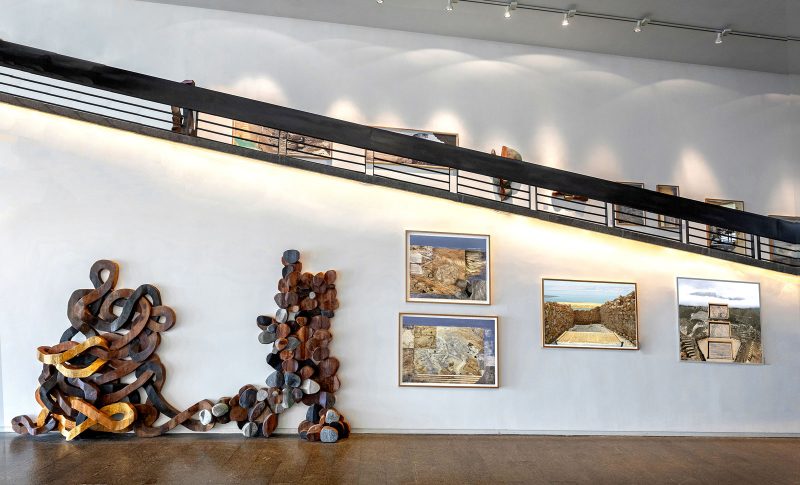
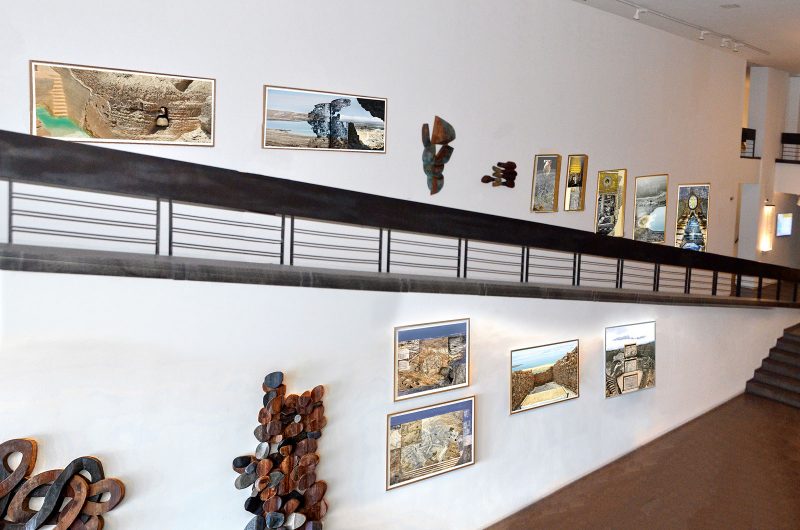
Notes
*Ralph Rugoff, “May You Live In Interesting Times,” exhibition catalog for the Biennale Arte 2019.
** Eiman Elgibreen, “Saudi Arabia,” in “May You Live In Interesting Times.” Exhibition catalog.
*** For extensive information on Jefferson and Hemings see: Annette Gordon-Reed, “Thomas Jefferson and Sally Hemings: An American Controversy,” University of Virginia Press, 1997 and “The Hemingses of Monticello: An American Family,” W. W. Norton & Company, 2009. See also: https://www.monticello.org/thomas-jefferson/jefferson-slavery/





